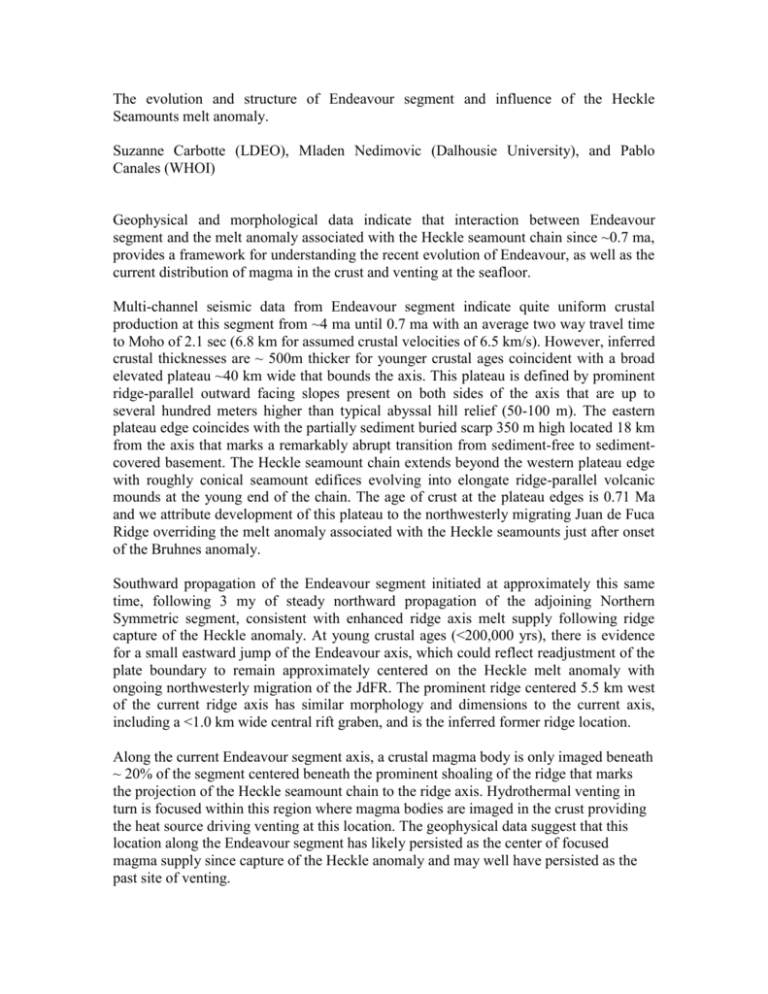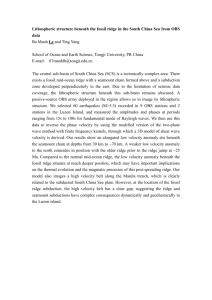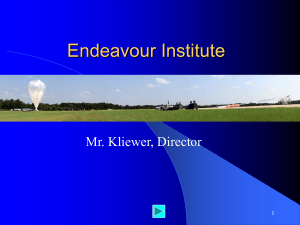Seismic and morphological indicators as well as magnetic
advertisement

The evolution and structure of Endeavour segment and influence of the Heckle Seamounts melt anomaly. Suzanne Carbotte (LDEO), Mladen Nedimovic (Dalhousie University), and Pablo Canales (WHOI) Geophysical and morphological data indicate that interaction between Endeavour segment and the melt anomaly associated with the Heckle seamount chain since ~0.7 ma, provides a framework for understanding the recent evolution of Endeavour, as well as the current distribution of magma in the crust and venting at the seafloor. Multi-channel seismic data from Endeavour segment indicate quite uniform crustal production at this segment from ~4 ma until 0.7 ma with an average two way travel time to Moho of 2.1 sec (6.8 km for assumed crustal velocities of 6.5 km/s). However, inferred crustal thicknesses are ~ 500m thicker for younger crustal ages coincident with a broad elevated plateau ~40 km wide that bounds the axis. This plateau is defined by prominent ridge-parallel outward facing slopes present on both sides of the axis that are up to several hundred meters higher than typical abyssal hill relief (50-100 m). The eastern plateau edge coincides with the partially sediment buried scarp 350 m high located 18 km from the axis that marks a remarkably abrupt transition from sediment-free to sedimentcovered basement. The Heckle seamount chain extends beyond the western plateau edge with roughly conical seamount edifices evolving into elongate ridge-parallel volcanic mounds at the young end of the chain. The age of crust at the plateau edges is 0.71 Ma and we attribute development of this plateau to the northwesterly migrating Juan de Fuca Ridge overriding the melt anomaly associated with the Heckle seamounts just after onset of the Bruhnes anomaly. Southward propagation of the Endeavour segment initiated at approximately this same time, following 3 my of steady northward propagation of the adjoining Northern Symmetric segment, consistent with enhanced ridge axis melt supply following ridge capture of the Heckle anomaly. At young crustal ages (<200,000 yrs), there is evidence for a small eastward jump of the Endeavour axis, which could reflect readjustment of the plate boundary to remain approximately centered on the Heckle melt anomaly with ongoing northwesterly migration of the JdFR. The prominent ridge centered 5.5 km west of the current ridge axis has similar morphology and dimensions to the current axis, including a <1.0 km wide central rift graben, and is the inferred former ridge location. Along the current Endeavour segment axis, a crustal magma body is only imaged beneath ~ 20% of the segment centered beneath the prominent shoaling of the ridge that marks the projection of the Heckle seamount chain to the ridge axis. Hydrothermal venting in turn is focused within this region where magma bodies are imaged in the crust providing the heat source driving venting at this location. The geophysical data suggest that this location along the Endeavour segment has likely persisted as the center of focused magma supply since capture of the Heckle anomaly and may well have persisted as the past site of venting. Taken together these observations suggest that presence of the Heckle mantle anomaly has influenced melt production at Endeavour segment for the past ~0.7 ma. Small offaxis seamount chains like the Heckles are common along intermediate and fast ridges but the nature of mantle processes that gives rise to these localized sites of volcanism and interaction with the ridge axis melt regime are not well understood. We are interested in integration of the geophysical observations from the Endeavour region with geochemical data and implications for the origin of these chains and the process of ridge-melt anomaly interaction in general.








